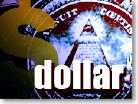|
Dollar shoulders to '99 high
|
 |
March 4, 1999: 4:38 p.m. ET
Sinking Japanese rates push yen lower, but bonds remain unimpressed
|
NEW YORK (CNNfn) - The dollar climbed to a three-month high against the yen Thursday, lifted by lingering euphoria over falling Japanese short-term interest rates and high yen liquidity in Tokyo money markets.
By late afternoon, the U.S. currency was trading at 123.75 yen, up nearly two yen from its previous close of 121.85. The last time the dollar had been so high was Nov. 30, shortly before fears of a fourth U.S. interest rate cut in as many months began to work in the yen's favor.
However, those fears have now been almost entirely buried. Currency markets now expect the Federal Open Market Committee to raise rather than lower U.S. rates when it next acts, while Japan has been forced to trim one of its already minimal key rates instead.
Higher U.S. interest rates generally encourage dollar buying by artificially curbing supply, raising demand.
Conversely, lower Japanese rates have pushed the yen down 8.38 percent since Feb. 12, when the Bank of Japan cut the overnight call rate to a record 0.10 percent.
The Bank of Japan is also responsible for the dollar's current swagger. On Thursday, the BOJ continued to flood Tokyo money markets with yen, sinking an estimated 300 billion yen ($2.7 billion) into the market to keep the unofficial overnight rate near zero.
The euro, itself subject to European rate cut speculation, withdrew from the resurgent dollar, falling to $1.079, the lowest point in its 10-week trading history.
Currency traders said would-be euro buyers were turning up their noses at news that the European Central Bank had once again refused to cut interest rates, instead looking toward euro-unfriendly indications that the German economy, Europe's powerhouse, had shrunk 0.4 percent in fourth-quarter 1998.
Bonds get little comfort
Analysts noted that the dollar's strength did little to melt the frigid bond market, where investors were almost wholly consumed by hesitation before the Labor Department's release of February payroll statistics Friday at 8:30 a.m. ET.
By late afternoon, the price of the benchmark 30-year Treasury bond was flat at 93-19/32 to yield 5.69 percent. Volume was exceptionally low, with many key players watching from the sidelines.
Recently unleashed fears of higher interest rates ahead have fixed the market's attention squarely on the upcoming labor figures as rate-sensitive bond investors attempt to gauge future monetary policy.
Federal Reserve Chairman Alan Greenspan, the chief U.S. interest-rate arbiter, is known to keep a specially sharp eye on the labor market for signs of impending wage inflation.
Economists predict the figures will show the labor market remaining tight, with 245,000 new jobs created in the month. Hourly earnings are expected to grow at a rate of 0.3 percent, a significant slowdown from last month's 0.5 percent.
If the numbers exceed the forecasts, bond yields are likely to rise again as would-be buyers turn up their noses at yet another sign of inflationary dangers ahead. However, if the numbers match expectations or even come in on the low side, the Treasury market could see a relief rally instead.
Meanwhile, Joel Kent, Lehman Brothers economist, said the bond market's icy reserve had prohibited Treasury prices from being heavily swayed by either the morning's lower-than-expected jobless data or a large Treasury coupon pass.
The Treasury pass, a buyback of government debt, trimmed existing 30-year bond supply by $762 million. 
|
|
|
|
|
 |

|

